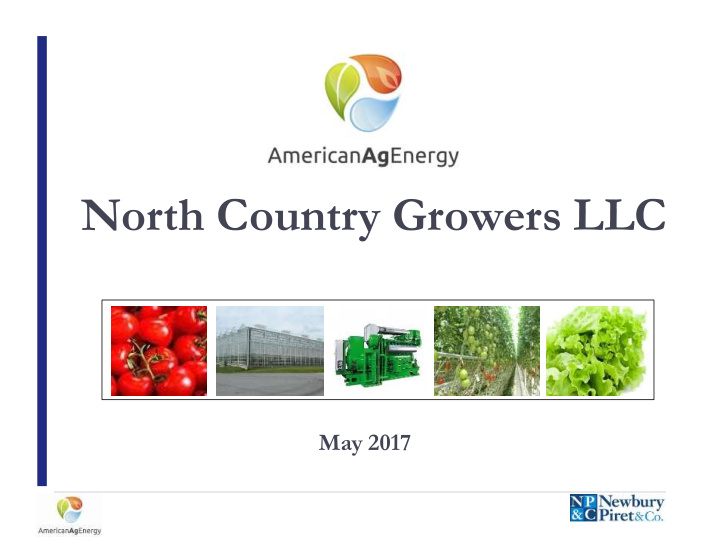



North Country Growers LLC May 2017 1
Presentation Outline • Who we are • What we do • Business opportunity: Berlin, NH • Requirements for a good project 2
3
Who We Are • American Ag Energy, Inc. (“Ag Energy”) was founded in 2009 and is based in Boston, MA • North Country Growers LLC (“NCG”) was created to own and operate the greenhouse facility in Berlin, NH • Management team experienced in greenhouse operations and power plant management • Talented engineering staff devoted to the sustainable production of healthy produce • Experienced business management 4
Key Personnel: Founders • Richard Rosen, PhD, Engineering, and Master of Forest Science, Harvard University • Lifetime grower of vegetables and flowers • 40 Year career in energy, environment, and sustainability • Marguerite Piret, MBA and AB, Harvard University • Expert in finance and operations • Experienced business executive and director of publicly traded companies • Harry Lewis, PhD and AB, Harvard University, Gordon-McKay Professor of Computer Science and Dean of Engineering, Harvard University • World Class Computer Science Expert and a specialist in information systems geared towards project control • H. Neil Nichols, Chartered Accountant • Former Treasurer of Canada Gas and Director of Keyspan • Expert in the supply of energy in general, and natural gas in particular 5
Key Personnel: Operations • Nic Helderman, Chief Grower • Nic has managed greenhouses all over the world, including Eurofresh Farms in Arizona and Backyard Farms in Madison, ME • Abuubakar Ally, Electrical Engineer, Harvard University • Samuel Gaeth, Environment and Health Engineer, Tufts University • Daniel Eisenberg, Project Manager, Chemical Engineer, MIT • Ronald Folger, Security Manager, University of Lowell 6
What We Do • North Country Growers develops combined heat and power facilities integrated with greenhouses to grow vegetables and flowers Electricity generation capacity is approximately 500 kW per acre of greenhouses Greenhouses efficiently utilize electricity, waste heat, and CO 2 produced by the combined heat and power facility Produce varieties are chosen to provide excellent taste and freshness Propagation is done on-site by specialists Operations are pesticide free and highly automated Produce is sustainably packaged on-site and sold to major supermarket chains and wholesale specialists Inspiring work environment 7
Environmental Advantages North Country Grower’s Combined Heat and Power (CHP) technology results in a significant reduction in energy use by recovering the waste heat produced during electricity generation and using it to heat the greenhouses CO 2 emissions are reduced by greenhouse consumption and fuels not-consumed in transport and heating Rainwater is used for hydroponic operations, resulting in no introduction of waste-water treatment chemicals and no adverse runoff Hydroponic fluids are recirculated, eliminating waste water discharges No artificial ripening agents are employed 8
Real Impact The combined heat and power activities of NCG reduce greenhouse energy requirements by approximately 10,000 mmBTU (1730 barrels of oil equivalent) per acre per year. For 20,000 pounds of lettuce, an average truck load, this equates to energy savings of 250 mmBTU and a corresponding 8,000 pound reduction in carbon dioxide emissions. A produce truck delivering from California to New England consumes 500 gallons of diesel fuel and emits 11,000 pounds of carbon dioxide EACH WAY. Delivery from NCG greenhouses will reduce the environmental impact associated with produce transportation by approximately 95%. 9
Business Opportunity: The Market The Market for fresh vegetables in the Northeast is large Fresh tomato consumption is 20 pounds per person per year Salad green consumption is 25 pounds per person per year Total consumption of fresh tomatoes in the Northeast is 1.5 billion pounds and total consumption of salad greens is 1.9 billion pounds 95% of produce consumed in the Northeast is currently imported from foreign countries, the West Coast, and Florida. A 20 acre greenhouse will provide approximately 0.8% of the Northeast’s demand for fresh tomatoes and 0.8% for lettuce, i.e. less than 1% The demand for locally-grown produce is increasing 10
Our Customers Our customers include supermarket chains: Wegmans Whole Foods Hannaford Brothers Wilson Farms 11
Requirements for Good Project Sufficient land of good quality that is flat and contains minimal wetlands and floodplain Access to natural gas pipeline Locally available work force Proximity to market Support of local community The Berlin, NH Site meets all of these requirements 12
Existing Greenhouse Operations in Europe • Energy consumption depends upon: • Latitude and lighting technology employed • Crop • Grower strategy • Energy output depends upon: • Number of hours Jenbacher is operated • Heating requirements during winter period • Cooling requirements during hot summer period • Price paid for electricity when electricity production is optional • General Electric expects the system to operates 8,300 hours/year, there are no technology issues relating to the CHP • Curtailments of natural gas are rarely an issue in Europe, but could be an issue in the United States. AAE mitigates this risk by the terms of the long term natural gas purchase agreement and by having stand-by supply of propane. 13
Recommend
More recommend